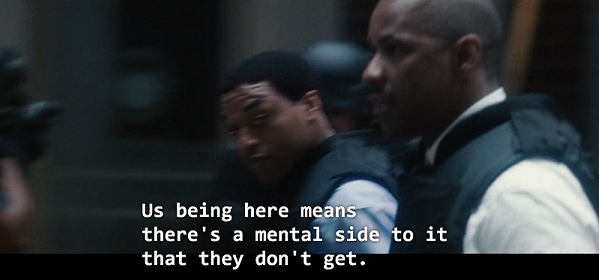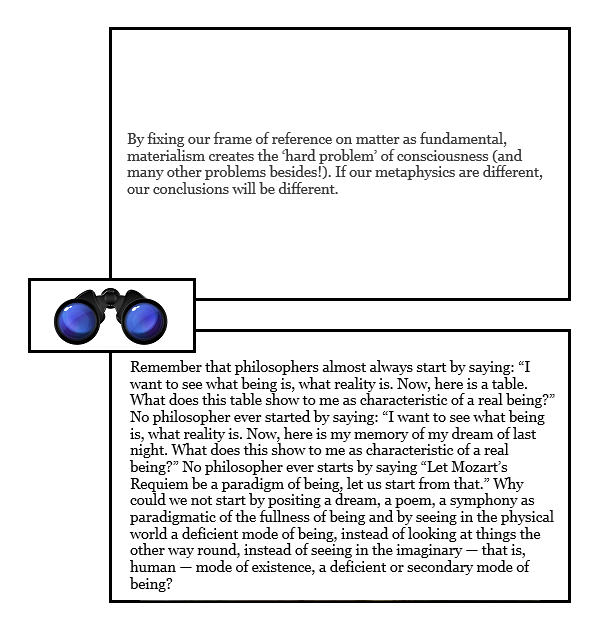[ by Charles Cameron — tracking a single pattern back and forth across the Cartesian divide between “inner” (subjective) and “outer” (objective) realities, and why ]
.

.
From God’s lips, figuratively speaking — via Mozart‘s mind and hand onto paper and out to musicians’ eyes and into their minds, then back out through their lips and hands and instruments and air — to your ears, and beyond? One pattern across a variety media.
We study Mozart’s biography. We study the “chunking” techniques a pianist typically uses to become proficient. My friend Wm. Benzon writes about how the brain’s oscillatory circuits can be internally synchronized through sonic activity and much more. We study how musical tastes correlate with education, or wealth, or class. What we don’t study nearly so intently, it seems to me, is the entire sequence by which a musical pattern makes its way from a composer’s initial thought to a listener’s delighted experience.
And what makes me want to talk about that is my sense that it requires thinking across the grain — across disciplines, across silos, across assumptions and languages and expectations.
It helps that I love Mozart. And I’m interested in the way patterns work. And perhaps most significantly, I believe that analytic mapping that doesn’t concern itself with both “inward” subjective experience, thought and emotions as well as “outer” realities, people, processes, and so forth will have us firing on only 50% of our cylinders at best. As I said in an earlier post on Anders Breivik:
A lot of our maps and models move between one quantity and another, and a lot of our thinking, correspondingly, has to do with materiel rather than morale — but nowhere is there a map or model of how quantity and quality affect each other, or how morale “force multiplies” materiel — even though “real life” moves seamlessly between (subjective, qualitative) mind and (objective, quantifiable) brain.
We have no map to walk us through the hard problem in consciousness — except our own insight.
And x-rays do not an insight make.
Let’s simply call this an early attempt to think about a stretch of the border between subjective and objective worlds, taking Mozart — a reasonably innocuous subject compared with Breivik — to start with.
**
There’s a phrase of music in Mozart’s head: it is a pattern – we shall see it later as a pattern in ink on paper, a pattern in keys depressed on a keyboard, on strings struck and vibrating, as a pattern in acoustic waves in air and a pattern of impacts on the ear drum, then of electrochemical activity in the brain, of “Mozart” in the mind – and perhaps in a tapping of the feet on the floor, and from thence, onwards…
Perhaps Mozart got it, this pattern, consciously or unconsciously, from the starling he wrote a poem to, and gave a burial to when it died [1, 2] … No doubt something of that pattern would have been in the starling’s brain as its throat muscles moved, and in the air that moved and he sang…
**
Something goes on with this pattern “inside” Mozart, and he composes, which is itself a hugely complex business involving various parts of his brain — and mind? Just brain, or brain and mind, or mind-brain? That’s the “hard question in consciousness” right there, and it applies as much to the starling, and the eventual listener, as it does to Mozart…
That “something” going on inside him has been variously described, in any case, and the historian William Stafford has written an enlightening piece comparing the myth of Mozart’s genius (Mozart himself used the term a couple of times in the classic sense of an intuitive guide, much as Socrates too would use the term) with the practicalities of musical skill and concentration.
**
Thus there is undoubtedly a romantic “Mozart the genius” slant to the account given by Mozart’s earliest biographer who, working with Mozart’s widow, described his process of composition in these terms:
Mozart wrote everything with a facility and rapidity, which perhaps at first sight could appear as carelessness or haste; and while writing he never came to the klavier. His imagination presented the whole work, when it came to him, clearly and vividly.
This idea is even more vividly expressed in the letter, purported to be Mozart’s own words but now widely considered a later effort by the publicist Friedrich Rochlitz and “attributed” to Mozart himself in the spirit of the times:
When I am, as it were, completely myself, entirely alone, and of good cheer — say, travelling in a carriage, or walking after a good meal, or during the night when I cannot sleep; it is on such occasions that my ideas flow best and most abundantly. Whence and how they come, I know not; nor can I force them. Those ideas that please me I retain in memory, and am accustomed, as I have been told, to hum them to myself. If I continue in this way, it soon occurs to me how I may turn this or that morsel to account, so as to make a good dish of it, that is to say, agreeably to the rules of counterpoint, to the peculiarities of the various instruments, etc.
All this fires my soul, and, provided I am not disturbed, my subject enlarges itself, becomes methodised and defined, and the whole, though it be long, stands almost complete and finished in my mind, so that I can survey it, like a fine picture or a beautiful statue, at a glance. Nor do I hear in my imagination the parts successively, but I hear them, as it were, all at once (gleich alles zusammen). What a delight this is I cannot tell! All this inventing, this producing, takes place in a pleasing lively dream. Still the actual hearing of the tout ensemble is after all the best. What has been thus produced I do not easily forget, and this is perhaps the best gift I have my Divine Maker to thank for.
When I proceed to write down my ideas, I take out of the bag of my memory, if I may use that phrase, what has been previously collected into it in the way I have mentioned. For this reason the committing to paper is done quickly enough, for everything is, as I said before, already finished; and it rarely differs on paper from what it was in my imagination…
**
In start contrast to this romantic picture, Stafford himself writes in his paper Mozart and Genius, and more briefly in his essay in the Cambridge Mozart Encyclopedia:
We must suspect a large element of myth-making in all of this, a construction of Mozart and his life in accordance with preconceived ideas.
and:
The real Mozart expressed pride in his craft, in the compositional skills he had learned from other musicians and taken to a high level. Much recent scholarship has emphasized the relationship of his creativity to his social milieu. In place of an unreflective genius who composed in a dream, it has given us, as in Konrad Kuster’s recent biography, a musician of the highest technical competence for whom composition presented a series of intellectual and aesthetic challenges that could only be surmounted with considerable effort.
**
I suspect that Stafford, too, is giving us his “construction of Mozart and his life in accordance with preconceived ideas”.
To my mind, it’s just that our own contemporary preconceptions have shifted the emphasis from the “inspiration” to the “perspiration” factor in understanding great works and the exceptional minds and mind-sets that produce them. In my view, both accounts have something to offer us – that what we retrospectively term “genius” happens when a prepared mind (meaning Stafford’s “compositional skills” and so forth) lets go of its controlling urgency, and a deeper, richer mind emerges — an emergence which takes places classically in reverie (Gaston Bachelard) or after some similar disengagement of the active will, from whence we get the phrase “let me sleep on it” in response to the posing of a tricky problem or dilemma
**
But the pattern.
No doubt there are a thousand ways in which Mozart differs from Beethoven, Beethoven from El Greco, El Greco from Einstein, Wittengenstein from Heraclitus, and Heraclitus from the Heraclitus who stepped into “the same river” a while ago…
What seems to be more stable is the pattern that Mozart wove, as it traveled from the throat of his starling through the intricacies of his own knowledge and practices, his friendships and tastes, his needs and longings and out onto paper, to a pianist or orchestra, and through instruments and voices into concert halls and magnetic wave forms and curious spirals engraved on discs, into sub-woofers and tweeters and full-range drivers..
And into our minds and hearts, our memories – our quiet hummings to ourselves on long autumn drives between motels.
**
I think we should track that pattern, know as much as we can of that pattern, write the biography of the way in which some piece of music weaves between inspiration and thought, composer and instrument, mind and matter, performer and audience, studio and home digital music center…
Then, perhaps, we could begin to map other patterns – in some ways simpler and more urgent ones.
Coming up shortly: Cross-grain thinking, 2: AQ’s #3 spot and mapping the jihadist mind. One thing you can be sure of: it will be different.







